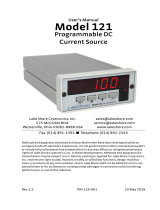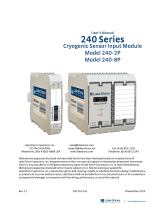
Lake Shore Model MTD-120/121 Crytotest System User’s Manual
Table of Contents i
TABLE OF CONTENTS
Chapter/Paragraph Title Page
List of Illustrations ........................................................................................................................... ii
List of Tables .................................................................................................................................. ii
Foreword ........................................................................................................................................ iii
Purpose and Scope........................................................................................................ iii
Hardware Covered ......................................................................................................... iii
Lake Shore Sensors....................................................................................................... iii
How To Use This Manual ............................................................................................... iii
Warning, Cautions, and Notes ....................................................................................... iii
General Installation Precautions..................................................................................... iii
Electrostatic Discharge................................................................................................... iv
Handling Electrostatic Discharge Sensitive Components .............................................. iv
Handling Cryogenic Storage Dewars ............................................................................. v
Liquid Helium and Nitrogen Safety Precautions ............................................................. v
Recommended First Aid................................................................................................. v
Safety Summary............................................................................................................. vi
Safety Symbols............................................................................................................... vi
1 INTRODUCTION ............................................................................................................................ 1-1
1.0 General........................................................................................................................... 1-1
1.1 MTD-120 Cryotest System General Description ............................................................ 1-1
1.2 MTD-120 Cryotest System Features .............................................................................. 1-3
1.3 Hardware Descriptions and Functions ........................................................................... 1-6
2 INSTALLATION.............................................................................................................................. 2-1
2.0 General........................................................................................................................... 2-1
2.1 Inspection and Unpacking .............................................................................................. 2-1
2.2 Repackaging For Shipment............................................................................................ 2-1
2.3 Environmental Requirements ......................................................................................... 2-1
2.4 System Power and Ground Requirements ..................................................................... 2-2
2.5 Physical Support Requirements ..................................................................................... 2-2
2.6 Liquid Cryogen................................................................................................................ 2-2
2.7 Instrumentation Hookup Instructions.............................................................................. 2-3
2.8 Miscellaneous Precautions............................................................................................. 2-3
2.9 Device Under Test (DUT) Insertion ................................................................................ 2-4
3 OPERATION................................................................................................................................... 3-1
3.0 General........................................................................................................................... 3-1
3.1 MTD System Operation .................................................................................................. 3-1
3.2 MTD System Shutdown.................................................................................................. 3-2
4 TROUBLESHOOTING ................................................................................................................... 4-1
4.0 General........................................................................................................................... 4-1
4.1 Water Condenses On Outer Surface Of Vacuum Chamber .......................................... 4-1
4.2 Unable To Reach Cold Terminal Temperature .............................................................. 4-1
4.3 No Response To Control Heater .................................................................................... 4-1
4.4 Cable Assembly.............................................................................................................. 4-1
5 OPTIONS, ACCESSORIES AND CABLES ................................................................................... 5-1
5.0 General........................................................................................................................... 5-1
5.1 MTD Cryotest System Options ....................................................................................... 5-1
5.2 Accessories .................................................................................................................... 5-1
APPENDIX A – UNITS FOR MAGNETIC PROPERTIES................................................................... A-1
































